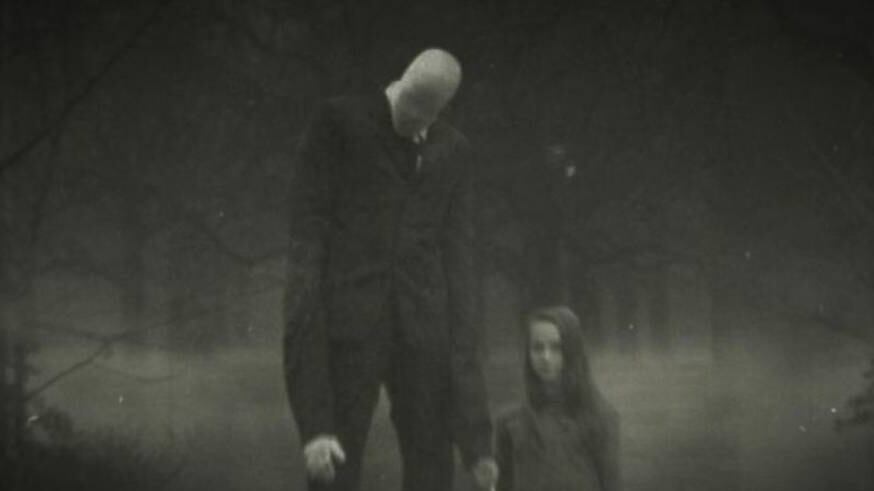A bicyclist discovered Payton Leutner, 12, on the side of the road covered in blood. It was May 31, 2014, and the young girl had crawled for dear life out of the nearby woods, where she’d been viciously stabbed 19 times in her arms, her legs, and her torso. She managed to survive, despite suffering major injuries to her vital organs. And she remembered who tried to kill her, leaving her alone amid the trees to bleed to death.
Even bigger shocks were in store for the suburban town of Waukesha, Wisconsin, when police apprehended Leutner’s alleged attackers—two other 12-year-old girls, one of them her longtime BFF—who blamed an unlikely culprit for making them do it: Slenderman, the thin, tall, faceless, child-preying boogeyman they’d come across on the Internet.
It seems these days we’re living in the midst of a true crime renaissance, particularly when those awful crimes seem to happen in the state of Wisconsin. Like Making a Murderer, the SXSW premiere documentary Beware the Slenderman probes beyond the headlines into the human side of a horrific act—in this case, a murder attempt five months in the making by Anissa Weier and Morgan Geyser on their unsuspecting classmate, whom they lured into the woods to kill one Saturday morning following Geyser’s sleepover birthday party.
ADVERTISEMENT
The girls later told police they tried to kill Leutner to appease the fictional Slenderman and gain permission to live in his mansion deep within the Nicolet National Forest, per one of the many iterations of Slenderman lore that exist online. Geyser, the one with long blonde hair and glasses, was the one who carried out the attack with a kitchen knife she’d lifted from home that morning.
“I’m so sorry,” she allegedly whispered in Leutner’s ear before stabbing her at Weier’s command.

Weier, also bespectacled, had shorter brown hair. Her parents and teacher recall her social isolation and struggles with bullying at school. Like Geyser, a fairly recent friend she’d made, she had a wildly imaginative streak that, online, tended towards the morbid. In court, she sometimes wore a tiny unkempt braid in her hair.
In footage from her interrogation the day of her arrest, she gamely raises her sweater to reveal the bloodstains on her shirt from dragging Leutner out of sight. There, she says, she told the wounded Leutner not to move “because you’ll lose blood slower,” and promised she and Geyser would go get help, even though they never intended to.
In Slenderman, director Irene Taylor Brodsky offers a fascinating counterpoint to the shocking attack by sitting for intimate interviews over the course of 18 months with Weier and Geyser’s staunchest defenders: their parents. We see home videos of both girls as babies, a stark juxtaposition to the chilling sights of watching them detail their murder plot in cold, emotionless detail. Brodsky makes a convincing case that both girls were primed to commit their Slenderman attack by mental and emotional instabilities, bolstered by a heartbreaking revelation during one interview. Tapping an intriguing panel of experts, the film detours into a thoughtful examination of how modern day memes are the new Grimms’ Fairy Tales for kids raised with iPads in their hands. It argues that Weier and Geyser’s fixation with the spooky Slenderman urban legend was an example of young, impressionable minds having too much access to scary content in the digital age—fair warning for parents with young children everywhere.
But in humanizing the two adolescents as emotionally susceptible social misfits who were swept away by a Slenderman delusion they believed to be real, the film offers viewers a one-sided empathetic viewpoint. It’s easy to think that we’re watching children with no grasp of the gravity of their actions, and easy to root for the distraught parents who can’t understand what would make their little girls commit such a heinous act, but want them to come home nonetheless.
That’s why the most provocative thing about Beware the Slenderman, which HBO is set to air this year, is its timing. The film advocates sympathy for Weier and Geyser on the eve of what may become a crucial moment in the girls’ pending legal case. After a judge declared last fall that Weier and Geyser should stand trial for first-degree attempted murder as adults—the law in Wisconsin states that “all murder and attempted-murder charges for children older than 10 start in adult court”—their lawyers filed appeals to have them tried as children, a condition that could mean the difference, if convicted, between them spending 65 years in prison vs. seeing release in a little over a decade, when they turn 25.
The status hearing to determine whether or not the pair is tried as adults or children is scheduled for next month. That makes the film supremely relevant from a buzz-building perspective, drafting off of a high profile SXSW debut. But it’s all the more troubling when you consider that Beware the Slenderman doesn’t allot comparable space to let the victim or her parents offer a counterpoint from their perspective. One might guess they’d have a very different argument to make.





